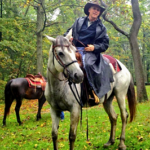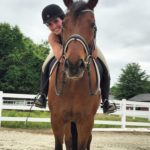
Many people talk about forming a partnership with their horse, but very few folks stop to think about what the horse needs to get out of this relationship.
We ask a lot of our horses. We expect them to overcome their most basic survival instincts just because we say they should. The amazing thing is that for thousands of years, horses have essentially acquiesced and done this. They let us climb on top of them, walk underneath them, pick up their feet, and stick fingers in their mouths. Because we have asked, they’ve pulled heavy, noisy things behind them and faced bullets and cannons as men rode them into battle.
Today, we ride them places they probably would not choose to go by themselves. We teach them to do odd things that stretch the limits of their actual physical capabilities.
And they do it for us.
Sure, we feed, water, and groom our horses. We try to keep them healthy with shots and deworming. We pay for medical attention when they need it. We provide shelter from the elements.
We may dress up their manes and tails in fancy ways and drape them in expensive tack that we think looks cool, but that’s mostly for our own benefit.
Lucky horses get pasture, buddy horses, pats, soft words, and solid training that they can understand. Even luckier horses get peace.
Horses want peace for the same reasons we do. Knowing this gives us a hugely powerful tool as we work toward building a lifelong friendship with our horses while also gaining great and safe performance.
We want to live in peace with our families, our co-workers, our friends, and our neighbors. So do our horses.
We don’t want to sit by uncomfortably and nervously twiddle our thumbs in rhythm with the butterflies in our stomach while our boss rants about our not doing something right-something that we haven’t been taught how to do. Our horses don’t want to be worried and unsure about what’s expected either. They don’t want to worry that they may be punished for something they don’t understand.
We want freedom from worry. So do our horses.
Recognizing the emotions going on inside our horses is as important as seeing what’s happening on the outside. Fear, worry, frustration, anger, and uncertainty are all unpleasant feelings, both for us and for our horses. Knowing that these emotions are the same in both people and horses gives us insight when our horses toss their heads, jig, wring their tails, or paw the ground nervously. When our horses are doing or feeling these things, they’re miserable.
Well, guess what? You and your horse want exactly the same thing! He doesn’t want to kick and you don’t want him to kick. He doesn’t want to be nervous and you don’t want him to be nervous. He doesn’t want to throw his head and you don’t want him to do that either. And it’s really important to know that you don’t have to make him stop or make his life worse by punishing him when he’s doing these things.
Knowing that your horse isn’t happy when he’s upset, unsure, worried, producing negative behavior, or giving you more energy than you’re asking for gives you a huge advantage when you begin to teach him what you want him to do. You don’t have to react or try to show him that he’s wrong. You can relax. You can smile. You can focus on showing him that everything is okay because you just want him to be easy on himself and move a specific body part in a specific way.
If you focus on something-anything-positive that you want your horse to do, you become your horse’s hero by showing him there’s a place where he can relax and find the peace he wants. This becomes a huge factor in everything you do with your horse.
It keeps you focused on what you want, not on what your horse happens to be doing at the time. You never have to correct or scold your horse because you’re only working on what you want, not what you don’t want. The training goes much faster because you don’t get sidetracked by “fixing” behavior. You never need to work on any behavior you don’t want your horse to do. It’s unnecessary, reactive, and negative. Instead, work only on the behavior you do want.
When you understand that you’re showing and not fixing, nothing you do with your hands will scare, hurt, or irritate your horse. Your job becomes easier because your hands are always showing the horse the direction you want his head or body part to go or how he is to move. Your hands are softer, more forgiving, more consistent, more sure of what they’re asking, and less reactive to what your horse is doing. Your hands are never focused on punishing him for what he’s doing wrong, so he relaxes and accepts your cues because he knows your hands have a reassuring way of telling him what he is to do that will make both of you happy.
This sounds simple, and it is once you get the hang of it, but like any change, it takes practice. If you stay focused and relaxed, if you keep an even keel with your own emotions, you will accomplish the same behavior in your horse.
Don’t change your actions because your horse’s behavior changes. You become the constant, reliable, and safe leader that the horse needs. Keep practicing your exercise or your lesson. Keep smiling, knowing that you and your horse want the same thing. You both want to relax and know everything is going to be okay. You’re not going to get hurt; your horse isn’t going to get hurt. No one is going to get mad at either of you and you’re going to have fun together.
Don’t correct. Guide. Don’t punish. Offer direction. Don’t make his life worse. Show him how nice his life can be. To offer your horse a place where he can have peace, you must always keep this concept clear in your own head when you’re working with him on any exercise.
Treat your horse as if he’s a person you just met at a dance who’s not sure of you or what you want. Hold the reins as if you’re holding onto that shy person’s hand. Show him or her that you’re trustworthy-you just want to dance. If they’re scared or nervous, they’ll be tense and the dance won’t look good or feel good for either of you. Your goal is to get your partner to relax so you can guide him or her around the dance floor as if you’re both floating on air.
Honest. In every situation, you and your horse want the same things. He’s willing to do anything for you. He’ll change his whole life just to find peace for a day, an hour, a minute, or a moment. You become his hero by giving him that wonderful, necessary peace. In the process, you both have a lot of fun and you both get what you want.







